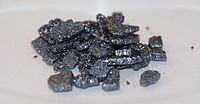
Photo from wikipedia
Ammonia uptake by high-capacity and high-porosity sorbents is a promising approach to its storage and release, capture and mitigation, and chemical separation. Here, we examined the ammonia sorption behavior of… Click to show full abstract
Ammonia uptake by high-capacity and high-porosity sorbents is a promising approach to its storage and release, capture and mitigation, and chemical separation. Here, we examined the ammonia sorption behavior of several versions of an archetypal zirconium-based metal-organic framework (MOF) material, NU-1000-a meso- and microporous crystalline compound having the empirical formula (1,3,6,8-tetrakis(p-benzoate)pyrene)2 Zr6(μ3-O)4(μ3-OH)4(H2O)4(OH)4 with linkers and nodes arranged to satisfy a csq topology. Depending on the thermal treatment protocol used prior to sorption measurements, ammonia can physisorb to NU-1000 via hydrogen-bonding and London-dispersion interactions and chemisorb via Brønsted acid-base reactions with node-integrated proton donors (μ3-hydroxos) and node-ligated proton donors (terminal hydroxos), via simple coordination at open Zr(IV) sites, or via dissociative coordination to Zr(IV) as NH2- and protonation of a node-based μ3-oxo. Ammonia adsorption occurs via both reversible and irreversible processes. The latter are of particular interest for protection and mitigation. Notably, the unexpected dissociative adsorption occurs only with nodes that have been fully dehydrated and irreversibly structurally distorted via thermal pre-treatment-a finding that is supported by density functional theory calculations. Differentiating and ranking the relative importance of the many modes of adsorption was facilitated, in part, by the availability of variants of NU-1000 that replace the majority of terminal aqua and hydroxo ligands with nonstructural formate ligands, auxiliary ditopic linkers, or both. The study provides insights into the chemical basis for both reversible and irreversible uptake of ammonia by Zr-MOFs and related compounds. The unexpectedly rich variety of sorption motifs suggest the criteria for designing or choosing MOFs that are optimal for specific ammonia-centric applications.
Journal Title: ACS applied materials & interfaces
Year Published: 2021
Link to full text (if available)
Share on Social Media: Sign Up to like & get
recommendations!